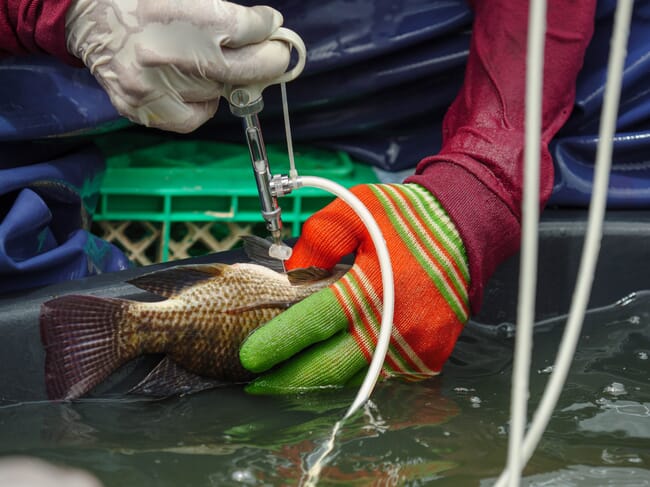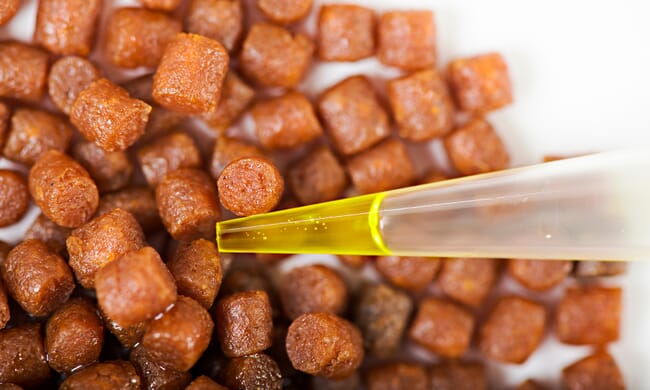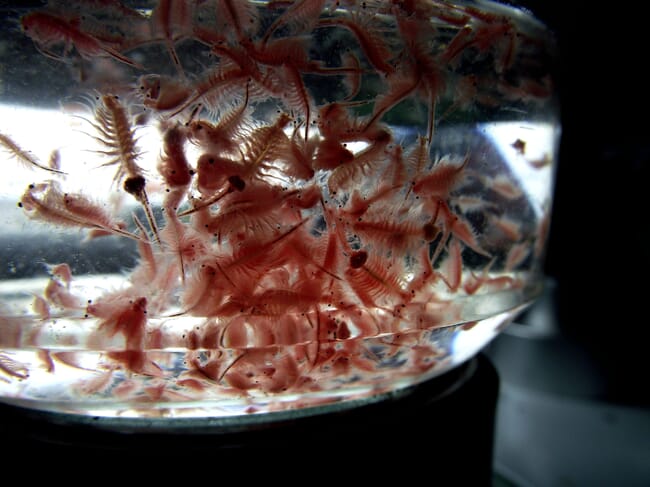
Researchers have reviewed various encapsulation methods that would keep oral vaccines viable after initial digestion © TransAlgae
The prevalence of infectious diseases in the aquaculture industry and the limited number of safe and effective oral vaccines has posed a challenge not only to both fish immunity and the wider aquaculture industry. More oral fish vaccines are becoming available, but researchers have outstanding questions on how they work and their impact on the immune system of fish.
A recurring challenge in developing oral fish vaccines relates to their efficacy – many of the active antigens contained in vaccines degrade in the gastrointestinal tract of fish. In light of this, researchers from the National College, Alagappa University and Saveetha University have reviewed various encapsulation methods that would keep oral vaccines viable after initial digestion. They have also outlined recent advancements in oral vaccination in aquaculture – and its role as a sustainable disease prevention measure.
Oral vaccination – protection status in aquaculture
Developing oral vaccination methods has been a significant advancement for the aquaculture industry. In many cases, manually injecting fish is unfeasible. High stocking densities at large farms means that vaccinating entire ponds or cages is labour intensive and causes stress for the fish.

Manually injecting fish is labour intensive and be stressful for the fish
Since oral vaccines can be administered by through feed or other dietary supplements, producers are able to boost the immunity of their stocks as part of daily husbandry activities. Oral vaccination also lets producers immunise large stocks of fish without causing additional biological stress. Oral vaccines can be delivered to fish by fortifying formulated feed with a coating, through encapsulating antigens in a diverse range of polymers or by the bioencapsulation process in live feeds like rotifers, water fleas and Artemia.
Despite the benefits of oral vaccines, there are few vaccines approved for use in the aquaculture sector. This low number was attributed to the lack of immune response when compared to injectable vaccines. Researchers noted that the vaccine antigens tended to degrade as they passed through the stomach of the fish.
The types of oral aquatic vaccines
There are various types of vaccines. Conventional varieties consist of inactivated organisms, live attenuated organism vaccines and protein subunit vaccines. For live attenuated vaccines, one or more viruses or bacteria have been modified to express lower virulence or inherent low pathogenicity towards the target fish species. Researchers can modify viruses or bacteria through physical or chemical methods, serial passage in cell culture, culture under aberrant circumstances and molecular genetic modification to create the active antigens.
Live-attenuated oral vaccines mimic live pathogen infection by stimulating the biological pathways and responses that upregulate immune factors associated with innate and adaptive immunity. These vaccines replicate within the host, allowing the animal to develop sufficient cellular memory and build long-lasting immunity.
According to the researchers, live attenuated vaccines are effective in most cases. However, they can present a risk if they revert to their virulent form – causing infectious diseases. Live attenuated vaccines can also be pathogenic in immunocompromised hosts and can have residual virulence.
Examples of live attenuated oral vaccines currently used in the aquaculture industry include Arthrobacter salmonid vaccine against bacterial kidney disease (BKD), catfish vaccine against Flavobacterium columnare, viral haemorrhagic septicaemia virus (VHSV) vaccine, a viral vaccine against Koi herpesvirus (KHV) for carp and attenuated V. anguillarum vaccine in rainbow trout.
Inactivated or killed oral vaccines
Whole cell killed or inactivated oral vaccines contain thermally or chemically killed pathogens in suspension, which can elicit a protective immune response against pathogens when administered to hosts susceptible to infectious diseases.

Oral vaccines can be delivered to fish by fortifying formulated feed © Nofima
Inactivated vaccines are used to suppress bacterial infections in fish, including those causing vibriosis and septicaemia-causing Aeromonas such as V. anguillarum, V. ordalli, Y. ruckeri, V. salmonicida and A. salmonicida. Killed oral vaccines are commercially available as formalin-inactivated whole cell vaccines that can be applied with or without adjuvants.
There are currently vaccines on the market that can tackle some pathogenic viruses in farmed fish, such as infectious pancreatic necrosis virus (IPNV), infectious hematopoietic necrosis virus (IHNV), viral haemorrhagic septicaemia virus (VHSV) and spring carp viraemia virus (SVCV).
Modern oral vaccines
Modern oral vaccine technologies in aquaculture use recombinant DNA vaccine technology, recombinant protein vaccines and peptide vaccines. The discovery of the immunogenic component or protein of a pathogen of interest, in addition to the validation of its pathogenicity in vivo and in vitro, is the first step in the production of a recombinant protein vaccine.
The purified IHNV and VHSV glycoproteins, for example, have been used as subunits of fish vaccines and have been shown to be immunoprotective, and, like recombinant vaccines, they are frequently used in aquaculture.

Live food, such as brine shrimp and Artemia, can be used as a vaccine delivery method © Benchmark
Encapsulated oral vaccines
Various forms of vaccine delivery are currently being studied. The key challenge is finding a way to preserve the integrity of the antigen before it reaches the site of the immunological target. Researchers are turning to an encapsulation technique that allows the antigenic compound to be integrated with a “carrier” that can protect it from the adverse gastric conditions of the fish.
There are three basic encapsulation techniques for vaccines: using adhesives like edible oil or gelatin, spraying the formulated food with liquid vaccine suspension and co-processing the antigen with aquafeed during the manufacturing process. However, the researchers report that these processes have disadvantages. Encapsulation can lead to the uneven distribution of the vaccine in feed and can inadvertently degrade the antigen due to directly exposing it to the digestive environment during feeding.
Encapsulation techniques have been modified with better strategies for better protection and immune response, such as alginate, chitosan, poly D,L-lactic-co-glycolic acid (PLGA) encapsulation, which have shown promising immune responses.
Vaccination has emerged as the most significant and sustainable solution for disease prevention and control in aquaculture. For vaccines to reach their full potential, they must be easy to administer, effective, powerful and safe – and come without consequences for humans and the environment surrounding fish farms.
Compared with other vaccination methods, oral vaccination methods can trigger the necessary immune response while imposing less stress on fish. These methods are also easier to administer and come at a relatively lower cost than manual techniques. The researchers note that nano-encapsulation is a promising method that could significantly increase vaccine production for aquaculture. Likewise, live food, such as brine shrimp, can be used as powerful biological carriers due to their small size and easy cultivation as food.




